An Internet-of-Things (IoT) Network System for Connected Safety and Health Monitoring Applications
Abstract
1. Introduction
2. Related Works
2.1. Wireless Technologies
2.2. IoT Gateway
2.3. Monitoring Applications
3. System Architecture
3.1. Wearable Network
3.2. IoT Gateway
3.3. IoT Cloud
3.4. Network Implementation
4. Implementation of the Sensor Node
4.1. Safe Node
4.1.1. Power Management Unit
4.1.2. Environmental Sensors
4.1.3. MCU and Wireless Transmission
4.1.4. Software Implementation for Safe Node
4.2. Health Node
4.2.1. Signal Processing Board
4.2.2. Physiological Sensors
4.2.3. Software Implementation
5. System Performance Evaluation and Analysis
5.1. Network Coverage
- Firstly, the IoT gateway is placed close to the window inside the laboratory on the second floor. Then we move the gateway to the top of the building to test the network coverage range when the gateway is at different gateway locations.
- Each sensor node is configured to send the data to the IoT gateway every minute.
- LoRa configuration: (1) Transmission power: 23 dBm; (2) Frequency: 915 MHz; (3) Spreading Factor = 128 chips/symbol (SpreadingFactor (SF) = 7); (4) BW = 125 kHz; (5) CR = 4/5.
5.2. Sensors’ Performance
6. Implementation of the IoT Gateway and Cloud Server
6.1. IoT Gateway Implementation
6.1.1. Hardware Implementation
- Internet connection interface, such as Wi-Fi or Ethernet;
- Relatively high processing speed;
- Data storage unit, such as MySQL database;
- User-friendly interface.
- One USB port of Pi is used to connect the LoRa, which enables the data acquisition from the local sensor network to the gateway database.
- MySQL database is installed in the Raspbian system for data storage. The data can be accessed in future if required.
- The built-in Wi-Fi module is used for Internet connection.
- MQTT messaging protocol is installed in the system for transmitting the data to the cloud server.
- A light-weight web server based on Node.js is installed and can be accessed via a smartphone and web browsers.
6.1.2. Software Implementation
6.2. IoT Cloud Server
7. Conclusions and Future Works
Author Contributions
Funding
Conflicts of Interest
References
- Gope, P.; Hwang, T. BSN-Care: A secure IoT-based modern healthcare system using body sensor network. IEEE Sens. J. 2016, 16, 1368–1376. [Google Scholar] [CrossRef]
- Wu, T.; Wu, F.; Redouté, J.M.; Yuce, M.R. An Autonomous Wireless Body Area Network Implementation Towards IoT Connected Healthcare Applications. IEEE Access 2017, 5, 11413–11422. [Google Scholar] [CrossRef]
- Wu, F.; Rüdiger, C.; Yuce, M.R. Real-Time Performance of a Self-Powered Environmental IoT Sensor Network System. Sensors 2017, 17, 282. [Google Scholar] [CrossRef] [PubMed]
- Yuce, M.R.; Khan, J. Wireless Body Area Networks: Technology, Implementation, and Applications; CRC Press: Boca Raton, FL, USA, 2011. [Google Scholar]
- Otto, C.; Milenkovic, A.; Sanders, C.; Jovanov, E. System architecture of a wireless body area sensor network for ubiquitous health monitoring. J. Mob. Multimed. 2006, 1, 307–326. [Google Scholar]
- Mahmud, M.S.; Wang, H.; Esfar-E-Alam, A.; Fang, H. A Wireless Health Monitoring System Using Mobile Phone Accessories. IEEE Internet Things J. 2017, 4, 2009–2018. [Google Scholar] [CrossRef]
- Wu, F.; Redouté, J.M.; Yuce, M.R. WE-Safe: A Self-Powered Wearable IoT Sensor Network for Safety Applications Based on LoRa. IEEE Access 2018, 6, 40846–40853. [Google Scholar] [CrossRef]
- Antolín, D.; Medrano, N.; Calvo, B.; Pérez, F. A wearable wireless sensor network for indoor smart environment monitoring in safety applications. Sensors 2017, 17, 365. [Google Scholar] [CrossRef]
- Blumthaler, M. UV Monitoring for Public Health. Int. J. Environ. Res. Public Health 2018, 15, 1723. [Google Scholar] [CrossRef]
- Fisk, W.J. A pilot study of the accuracy of CO2 sensors in commercial buildings. In Proceedings of the IAQ 2007 Healthy and Sustainable Buildings, Baltimore, MD, USA, 15–17 October 2007. [Google Scholar]
- Wilhelm, E.; Siby, S.; Zhou, Y.; Ashok, X.J.S.; Jayasuriya, M.; Foong, S.; Kee, J.; Wood, K.L.; Tippenhauer, N.O. Wearable environmental sensors and infrastructure for mobile large-scale urban deployment. IEEE Sens. J. 2016, 16, 8111–8123. [Google Scholar] [CrossRef]
- Kotz, D.; Fu, K.; Gunter, C.; Rubin, A. Security for mobile and cloud frontiers in healthcare. Commun. ACM 2015, 58, 21–23. [Google Scholar] [CrossRef]
- Castiglione, A.; DAmbrosio, C.; De Santis, A.; Castiglione, A.; Palmieri, F. On secure data management in health-care environment. In Proceedings of the 2013 Seventh International Conference on Innovative Mobile and Internet Services in Ubiquitous Computing (IMIS), Taichung, Taiwan, 3–5 July 2013; pp. 666–671. [Google Scholar]
- Yuce, M.R. Implementation of wireless body area networks for healthcare systems. Sens. Actuators A Phys. 2010, 162, 116–129. [Google Scholar] [CrossRef]
- Aloi, G.; Caliciuri, G.; Fortino, G.; Gravina, R.; Pace, P.; Russo, W.; Savaglio, C. Enabling IoT interoperability through opportunistic smartphone-based mobile gateways. J. Netw. Comput. Appl. 2017, 81, 74–84. [Google Scholar] [CrossRef]
- Mekki, K.; Bajic, E.; Chaxel, F.; Meyer, F. A comparative study of LPWAN technologies for large-scale IoT deployment. ICT Express 2018. In Press. [Google Scholar] [CrossRef]
- Zhang, X.; Zhang, M.; Meng, F.; Qiao, Y.; Xu, S.; Hour, S.H. A Low-Power Wide-Area Network Information Monitoring System by Combining NB-IoT and LoRa. IEEE Internet Things J. 2018. [Google Scholar] [CrossRef]
- Sinha, R.S.; Wei, Y.; Hwang, S.H. A survey on LPWA technology: LoRa and NB-IoT. Ict Express 2017, 3, 14–21. [Google Scholar] [CrossRef]
- Bor, M.; Vidler, J.E.; Roedig, U. LoRa for the Internet of Things. In Proceedings of the 2016 International Conference on Embedded Wireless Systems and Networks, Graz, Austria, 15–17 February 2016. [Google Scholar]
- Centenaro, M.; Vangelista, L.; Zanella, A.; Zorzi, M. Long-range communications in unlicensed bands: The rising stars in the IoT and smart city scenarios. IEEE Wirel. Commun. 2016, 23, 60–67. [Google Scholar] [CrossRef]
- de Carvalho Silva, J.; Rodrigues, J.J.; Alberti, A.M.; Solic, P.; Aquino, A.L. LoRaWAN—A low power WAN protocol for Internet of Things: A review and opportunities. In Proceedings of the 2017 2nd International Multidisciplinary Conference on Computer and Energy Science (SpliTech), Split, Croatia, 12–14 July 2017; pp. 1–6. [Google Scholar]
- Blenn, N.; Kuipers, F. LoRaWAN in the wild: Measurements from the things network. arXiv, 2017; arXiv:1706.03086. [Google Scholar]
- Trasviña-Moreno, C.A.; Blasco, R.; Marco, Á.; Casas, R.; Trasviña-Castro, A. Unmanned aerial vehicle based wireless sensor network for marine-coastal environment monitoring. Sensors 2017, 17, 460. [Google Scholar] [CrossRef] [PubMed]
- Mdhaffar, A.; Chaari, T.; Larbi, K.; Jmaiel, M.; Freisleben, B. IoT-based health monitoring via LoRaWAN. In Proceedings of the IEEE EUROCON 2017-17th International Conference on Smart Technologies, Ohrid, Macedonia, 6–8 July 2017; pp. 519–524. [Google Scholar]
- Petäjäjärvi, J.; Mikhaylov, K.; Yasmin, R.; Hämäläinen, M.; Iinatti, J. Evaluation of LoRa LPWAN technology for indoor remote health and wellbeing monitoring. Int. J. Wirel. Inf. Netw. 2017, 24, 153–165. [Google Scholar] [CrossRef]
- Rahmani, A.M.; Gia, T.N.; Negash, B.; Anzanpour, A.; Azimi, I.; Jiang, M.; Liljeberg, P. Exploiting smart e-Health gateways at the edge of healthcare Internet-of-Things: A fog computing approach. Future Gener. Comput. Syst. 2018, 78, 641–658. [Google Scholar] [CrossRef]
- Pace, P.; Aloi, G.; Gravina, R.; Caliciuri, G.; Fortino, G.; Liotta, A. An Edge-based Architecture to Support Efficient Applications for Healthcare Industry 4.0. IEEE Trans. Ind. Informat. 2018. [Google Scholar] [CrossRef]
- Rahmani, A.M.; Thanigaivelan, N.K.; Gia, T.N.; Granados, J.; Negash, B.; Liljeberg, P.; Tenhunen, H. Smart e-health gateway: Bringing intelligence to internet-of-things based ubiquitous healthcare systems. In Proceedings of the 2015 12th Annual IEEE Consumer Communications and Networking Conference (CCNC), Las Vegas, NV, USA, 9–12 January 2015; pp. 826–834. [Google Scholar]
- Shi, W.; Cao, J.; Zhang, Q.; Li, Y.; Xu, L. Edge computing: Vision and challenges. IEEE Internet Things J. 2016, 3, 637–646. [Google Scholar] [CrossRef]
- Bonomi, F.; Milito, R.; Zhu, J.; Addepalli, S. Fog computing and its role in the internet of things. In Proceedings of the First Edition of the MCC Workshop on Mobile Cloud Computing, Helsinki, Finland, 17 August 2012; pp. 13–16. [Google Scholar]
- Yan, J.; Wu, D.; Zhang, C.; Wang, H.; Wang, R. Socially aware D2D cooperative communications for enhancing Internet of Things application. EURASIP J. Wirel. Commun. Netw. 2018, 2018, 132. [Google Scholar] [CrossRef]
- Chen, M.; Ma, Y.; Song, J.; Lai, C.F.; Hu, B. Smart clothing: Connecting human with clouds and big data for sustainable health monitoring. Mob. Netw. Appl. 2016, 21, 825–845. [Google Scholar] [CrossRef]
- Yang, Z.; Zhou, Q.; Lei, L.; Zheng, K.; Xiang, W. An IoT-cloud Based Wearable ECG Monitoring System for Smart Healthcare. J. Med. Syst. 2016, 40, 286. [Google Scholar] [CrossRef] [PubMed]
- Zhu, Z.; Liu, T.; Li, G.; Li, T.; Inoue, Y. Wearable sensor systems for infants. Sensors 2015, 15, 3721–3749. [Google Scholar] [CrossRef] [PubMed]
- Catarinucci, L.; De Donno, D.; Mainetti, L.; Palano, L.; Patrono, L.; Stefanizzi, M.L.; Tarricone, L. An IoT-aware architecture for smart healthcare systems. IEEE Internet Things J. 2015, 2, 515–526. [Google Scholar] [CrossRef]
- Misra, V.; Bozkurt, A.; Calhoun, B.; Jackson, T.; Jur, J.S.; Lach, J.; Lee, B.; Muth, J.; Oralkan, Ö.; Öztürk, M.; et al. Flexible technologies for self-powered wearable health and environmental sensing. Proc. IEEE 2015, 103, 665–681. [Google Scholar] [CrossRef]
- Thangavel, D.; Ma, X.; Valera, A.; Tan, H.X.; Tan, C.K.Y. Performance evaluation of MQTT and CoAP via a common middleware. In Proceedings of the 2014 IEEE Ninth International Conference on Intelligent Sensors, Sensor Networks and Information Processing (ISSNIP), Singapore, 21–24 April 2014; pp. 1–6. [Google Scholar]
- Jaffey, T. MQTT and CoAP, IoT Protocols. Available online: https://www.eclipse.org/community/eclipse_newsletter/2014/572february/article2.php (accessed on 10 December 2018).
- Wu, T.; Redouté, J.M.; Yuce, M.R. A Wearable Wireless Medical Sensor Network System towards Internet-of-Patients. In Proceedings of the 2018 IEEE Sensors, New Delhi, India, 28–31 October 2018. [Google Scholar]
- Microchip Technology. Ultra-Low Quiescent Current LDO Regulator MCP1810 [Datasheet]. 2016. Available online: http://ww1.microchip.com/downloads/en/DeviceDoc/20005623A.pdf (accessed on 10 November 2018).
- Texas Instruments. TPS22908 [Datasheet]. 2015. Available online: http://www.ti.com/lit/ds/symlink/tps22908.pdf (accessed on 10 November 2018).
- Bosch Sensortec. BME680 Low Power Gas, Pressure, Temperature & Humidity Sensor [Datasheet]. 2017. Available online: https://cdn-shop.adafruit.com/product-files/3660/BME680.pdf (accessed on 10 November 2018).
- Silicon Labs. Si1145/46/47 Proximity/UV/Ambient Light Sensor IC With I2C Interface [Datesheet]. 2014. Available online: https://www.allaboutcircuits.com/uploads/articles/si1145-46-47.pdf (accessed on 10 November 2018).
- Sensors, M. GSS Sensor User’s Manual. Available online: http://www.co2meters.com/Documentation/Manuals/Manual-GSS-Sensors.pdf (accessed on 20 November 2018).
- RF Digital Corporation. Simblee™ Bluetooth® Smart Module RFD77101 [Datasheet]. Available online: https://www.simblee.com/Simblee%20RFD77101%20Datasheet%20v2.2.pdf (accessed on 10 November 2018).
- Hope Microelectronics, Co. RFM95/96/97/98(W) [Datasheet]. 2014. Available online: https://cdn.sparkfun.com/assets/a/e/7/e/b/RFM95_96_97_98W.pdf (accessed on 10 November 2018).
- McCauley, M. RadioHead Packet RadiO Library for Embedded Microprocessors. Available online: http://www.airspayce.com/mikem/arduino/RadioHead/ (accessed on 20 November 2018).
- Weatherley, R. Arduino Cryptography Library. 2018. Available online: https://github.com/rweather/arduinolibs (accessed on 20 November 2018).
- Lee, J.; Matsumura, K.; Yamakoshi, K.i.; Rolfe, P.; Tanaka, S.; Yamakoshi, T. Comparison between red, green and blue light reflection photoplethysmography for heart rate monitoring during motion. Conf. Proc. IEEE Eng. Med. Biol. Soc. 2013, 2013, 1724–1727. [Google Scholar] [PubMed]
- Maxim Integrated. Human Body Temperature Sensor MAX30205 Human Body Temperature Sensor Absolute Maximum Ratings [Datasheet]. 2016. Available online: https://datasheets.maximintegrated.com/en/ds/MAX30205.pdf (accessed on 20 November 2018).
- Ray, P.P. A survey on Internet of Things architectures. J. King Saud Univ.-Comput. Inf. Sci. 2018, 30, 291–319. [Google Scholar] [CrossRef]
- Maksimović, M.; Vujović, V.; Davidović, N.; Milošević, V.; Perišić, B. Raspberry Pi as Internet of things hardware: performances and constraints. Des. Issues 2014, 3, 8. [Google Scholar]
- Dieffenderfer, J.; Goodell, H.; Mills, S.; McKnight, M.; Yao, S.; Lin, F.; Beppler, E.; Bent, B.; Lee, B.; Misra, V.; et al. Low-power wearable systems for continuous monitoring of environment and health for chronic respiratory disease. IEEE J. Biomed. Health Informat. 2016, 20, 1251–1264. [Google Scholar] [CrossRef] [PubMed]
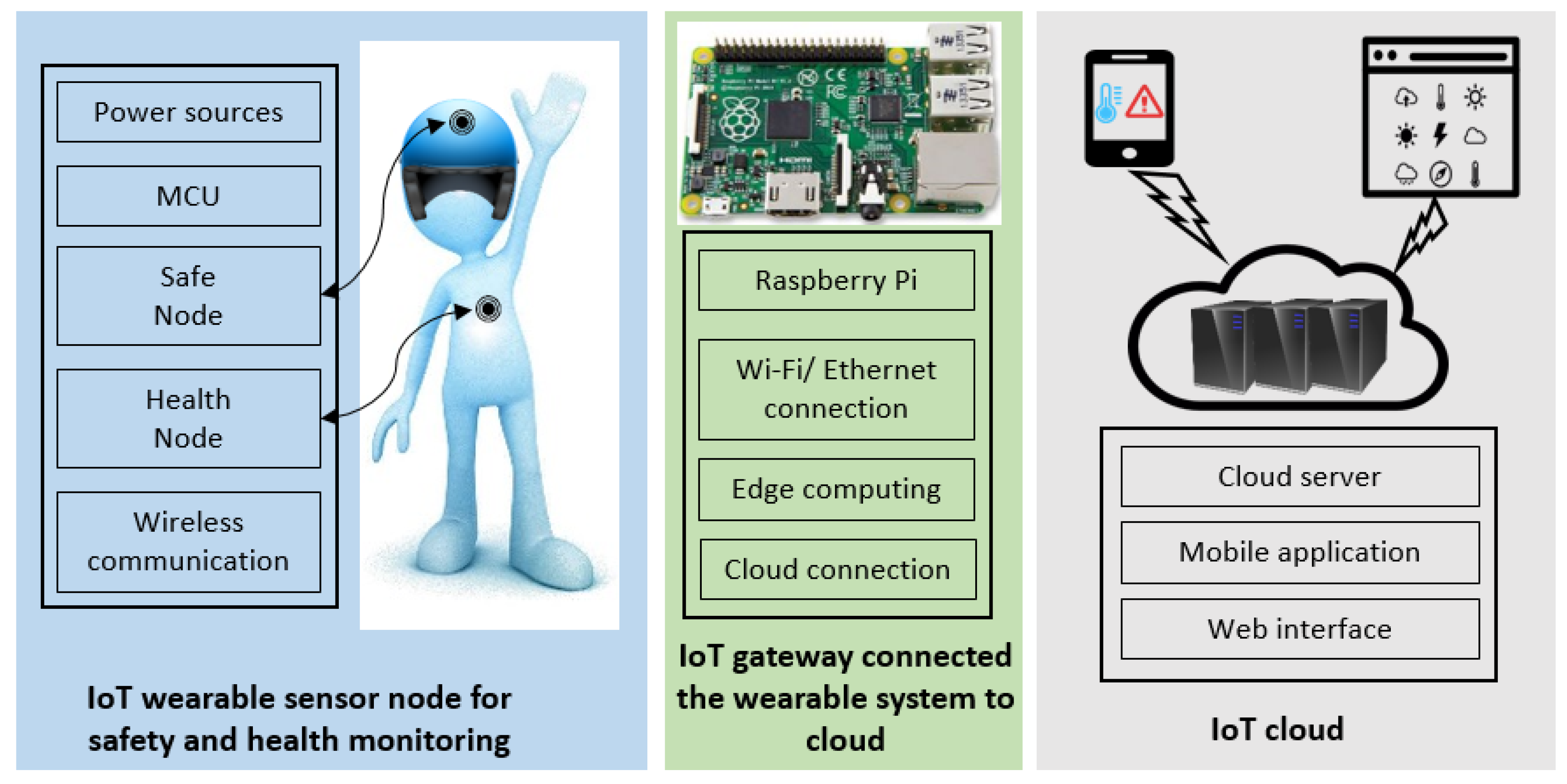
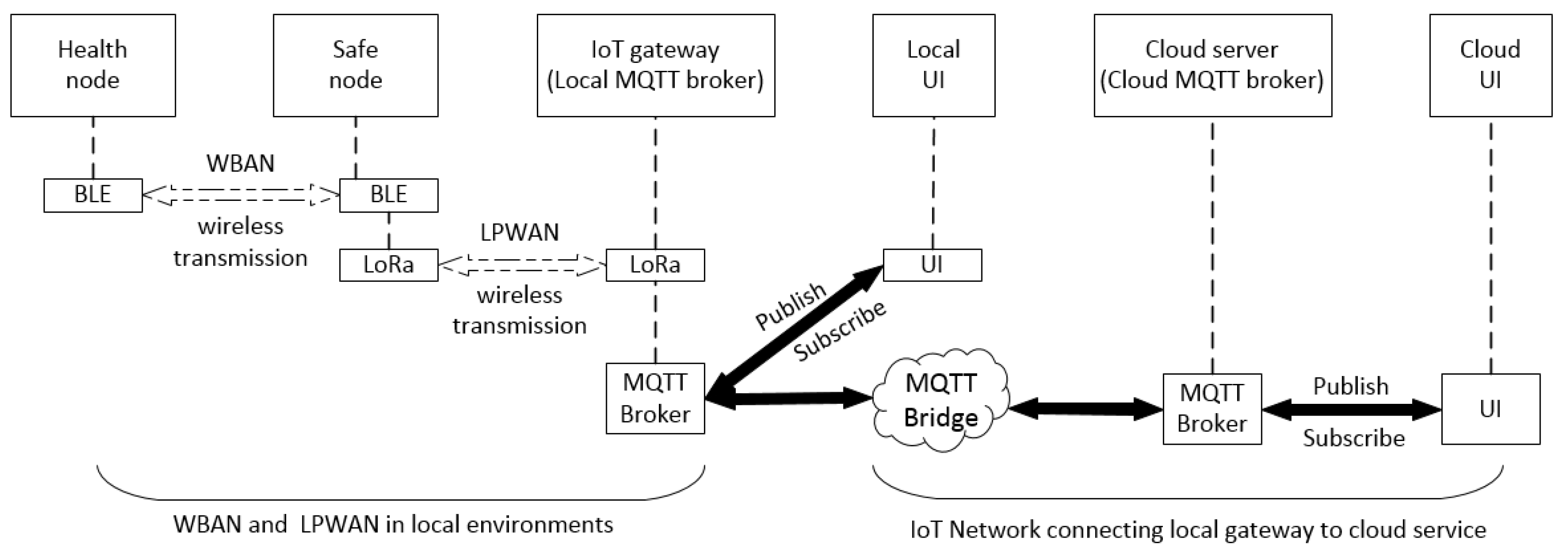
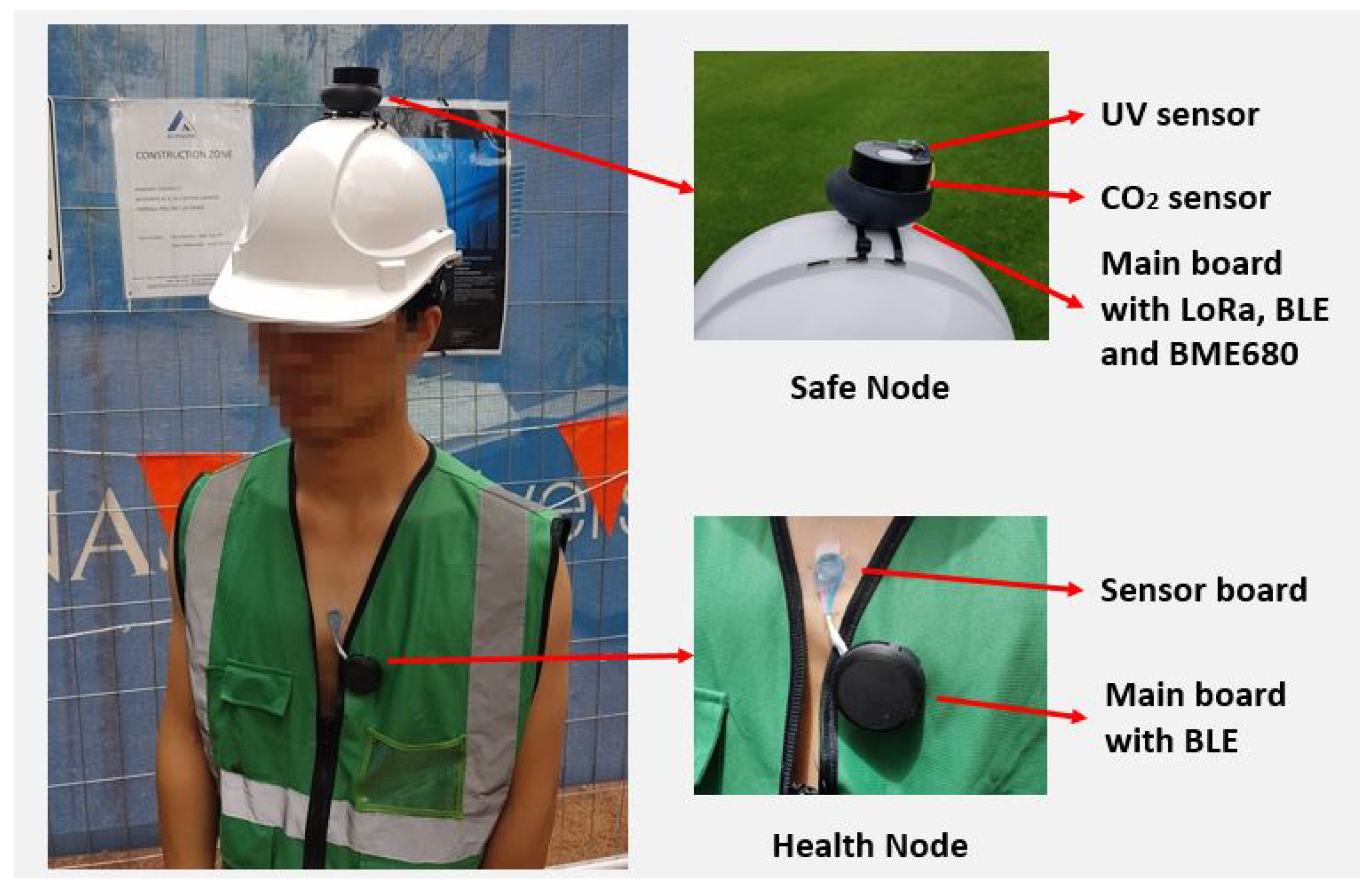
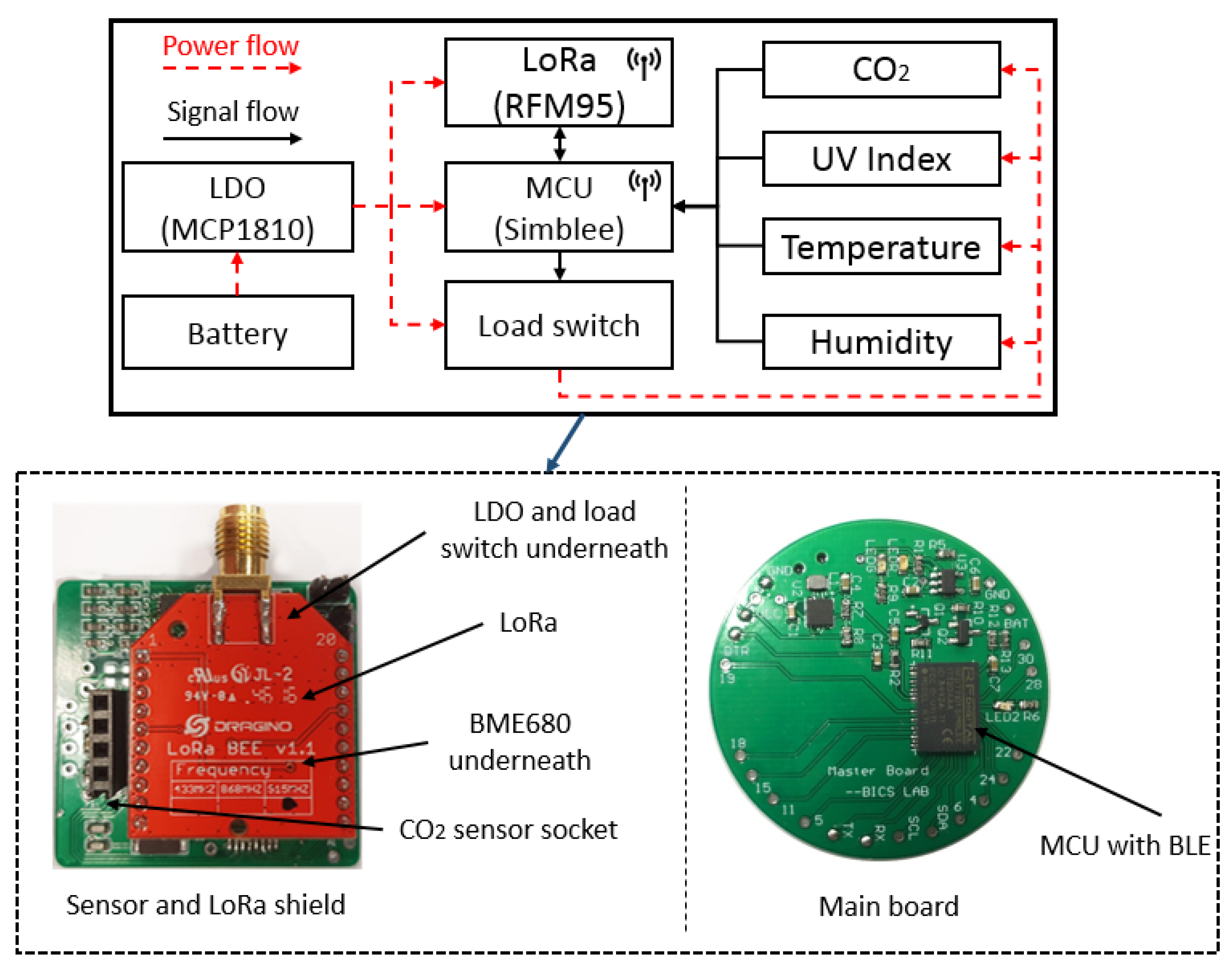
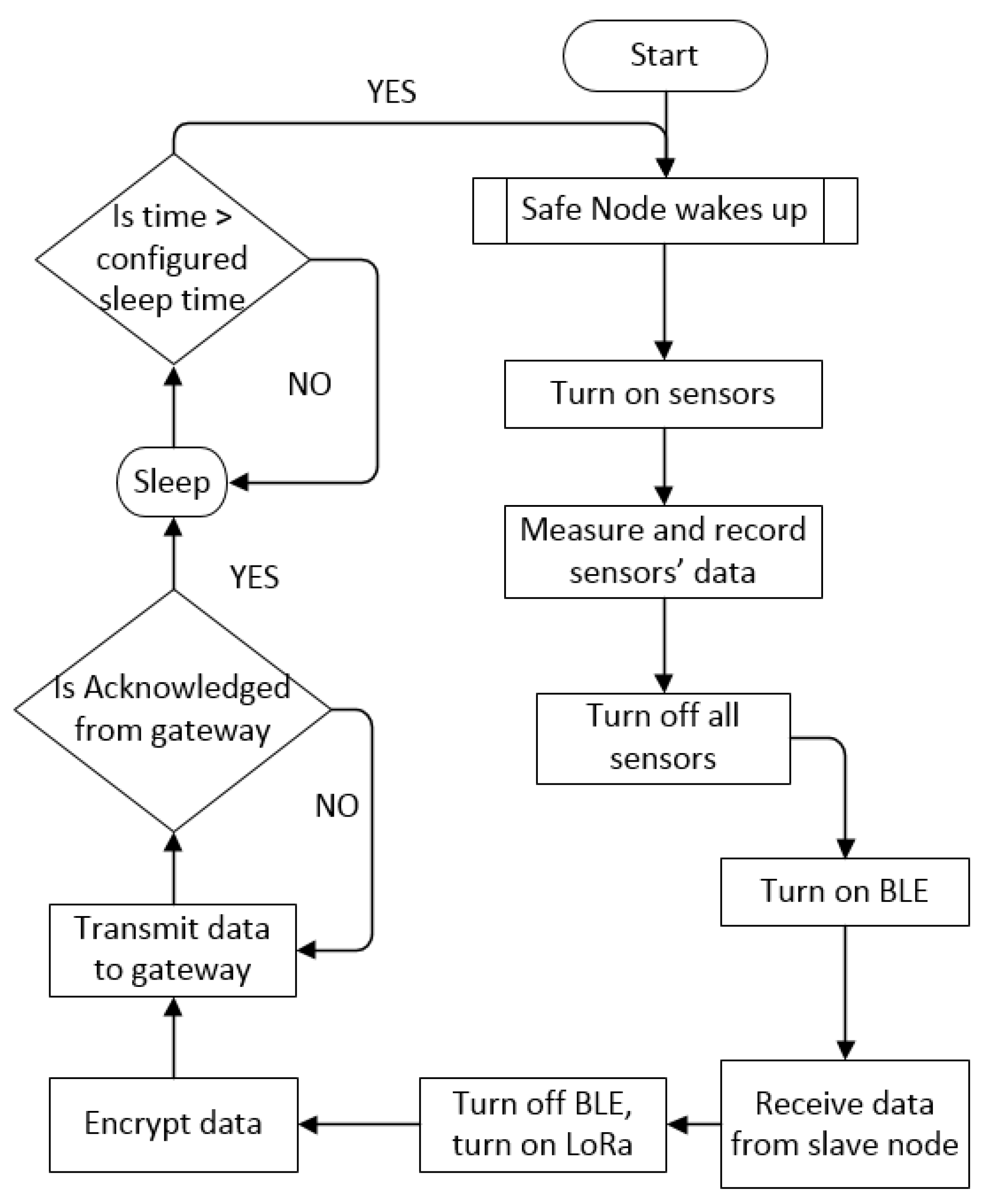


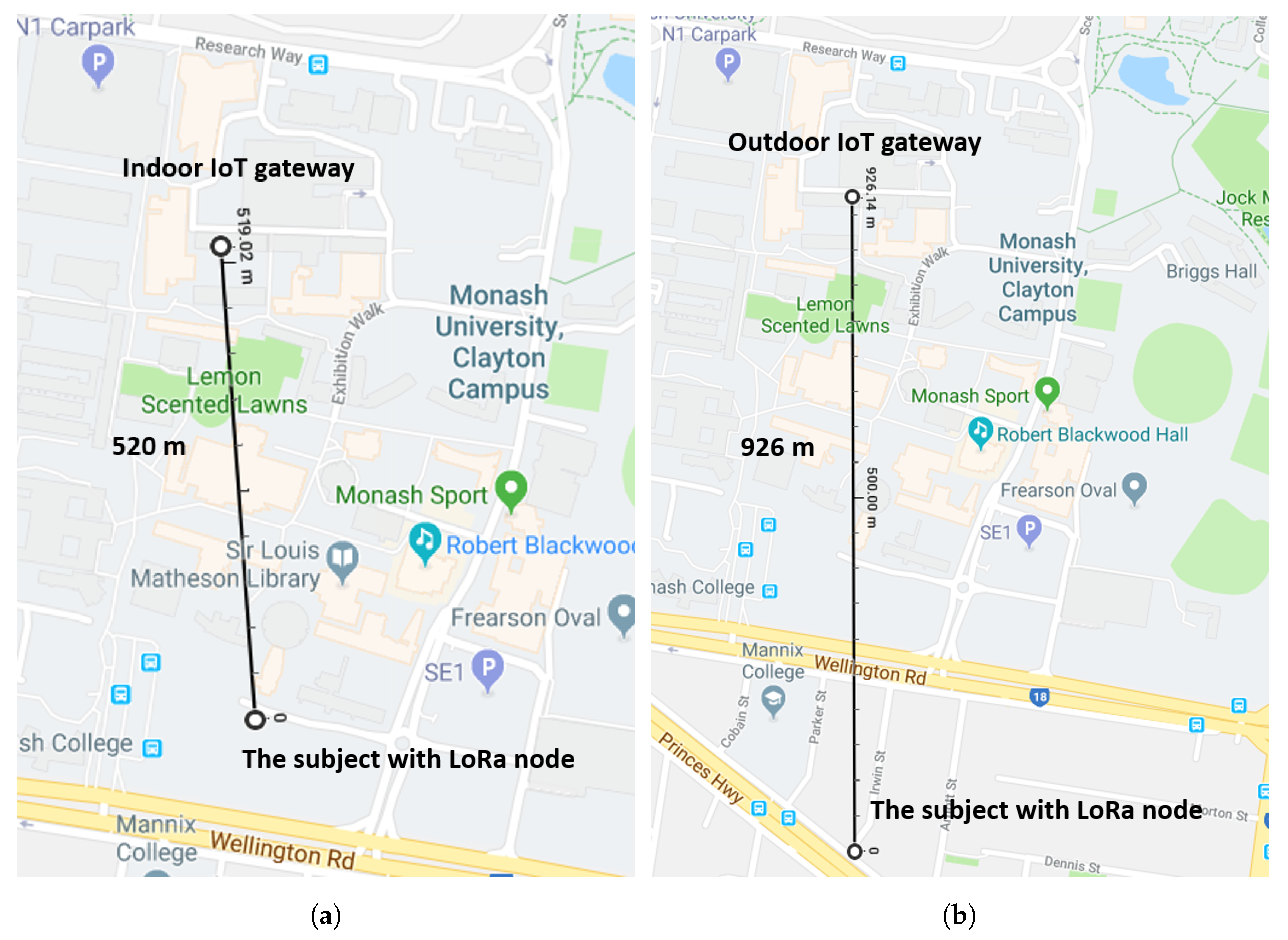
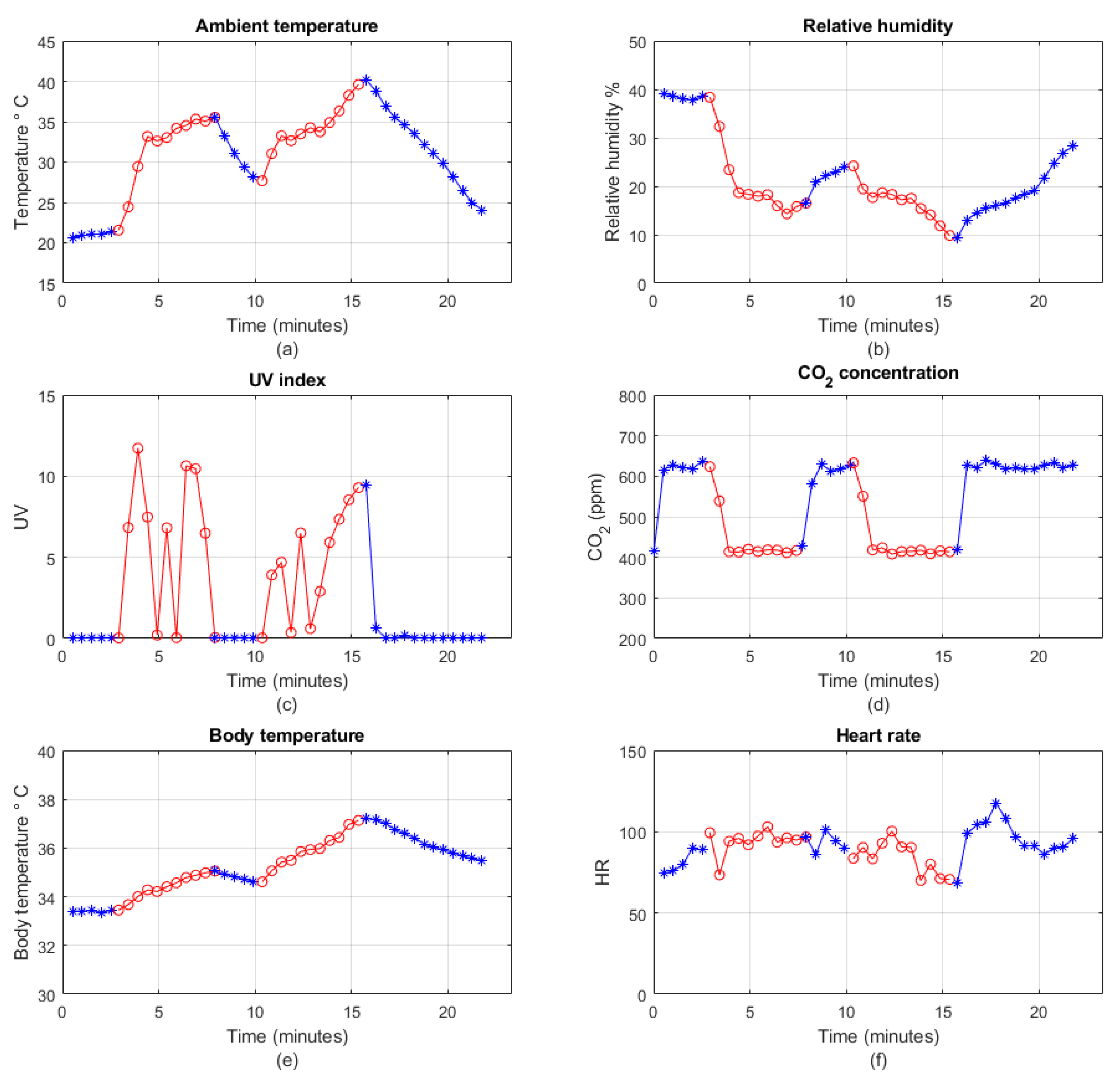
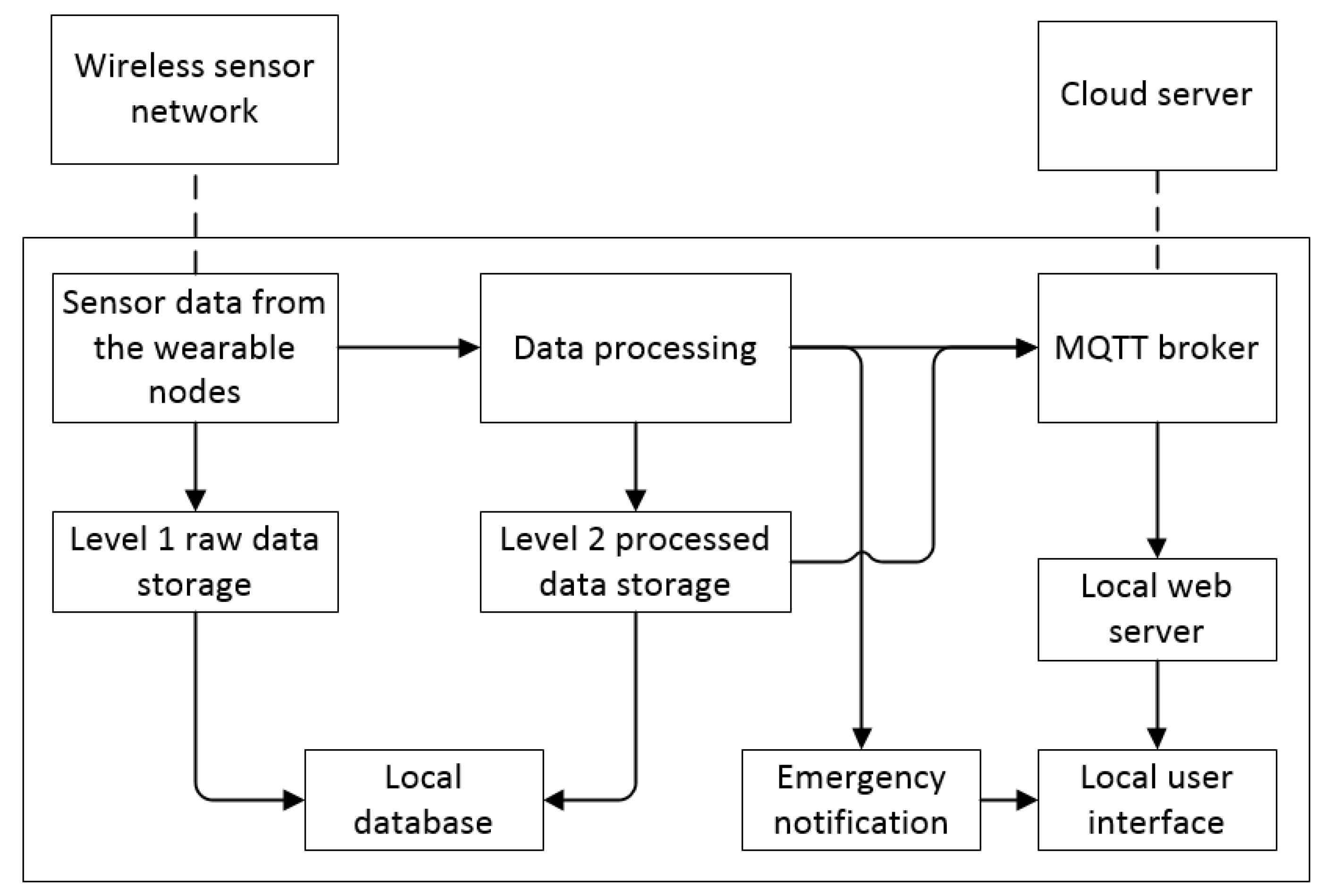

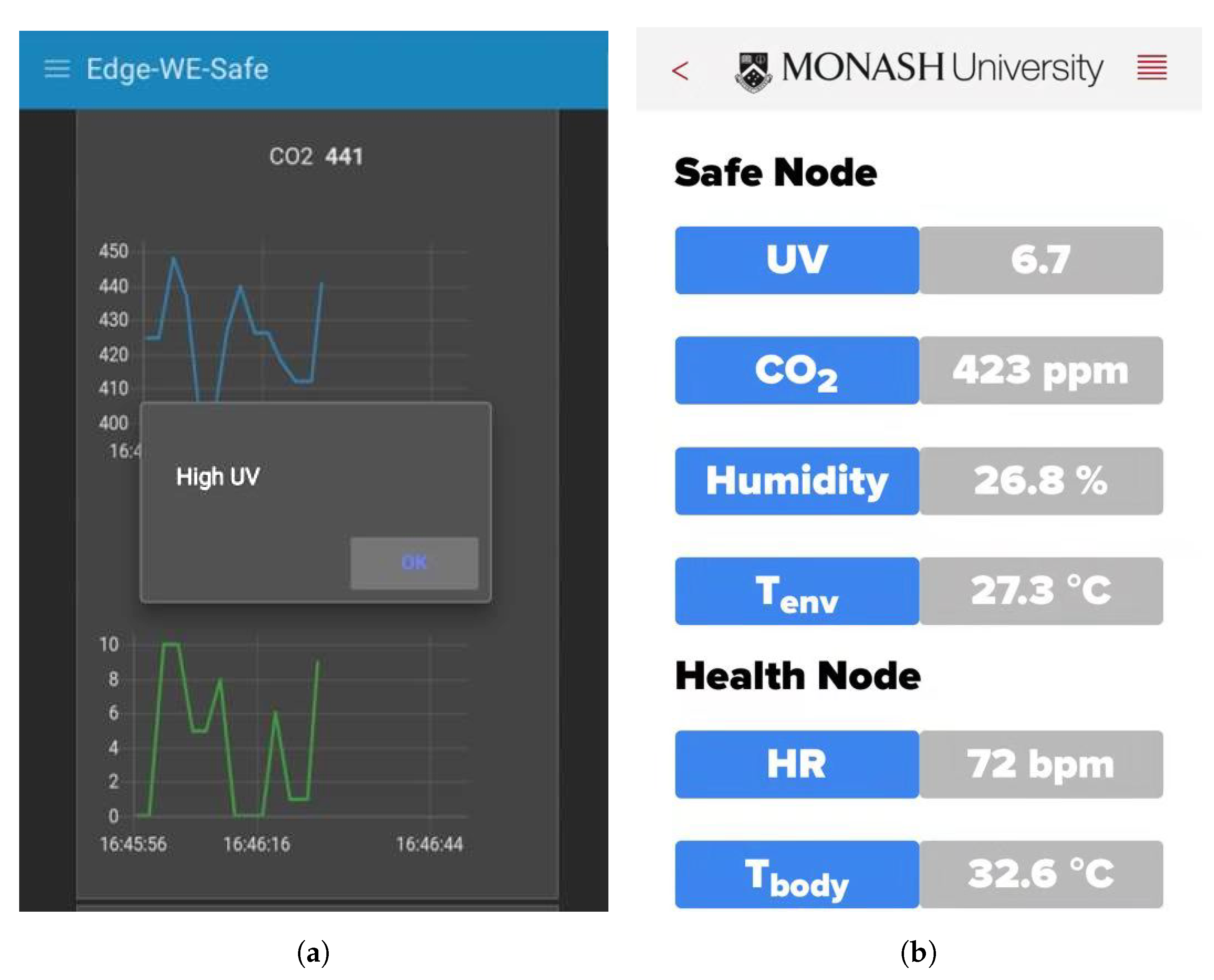
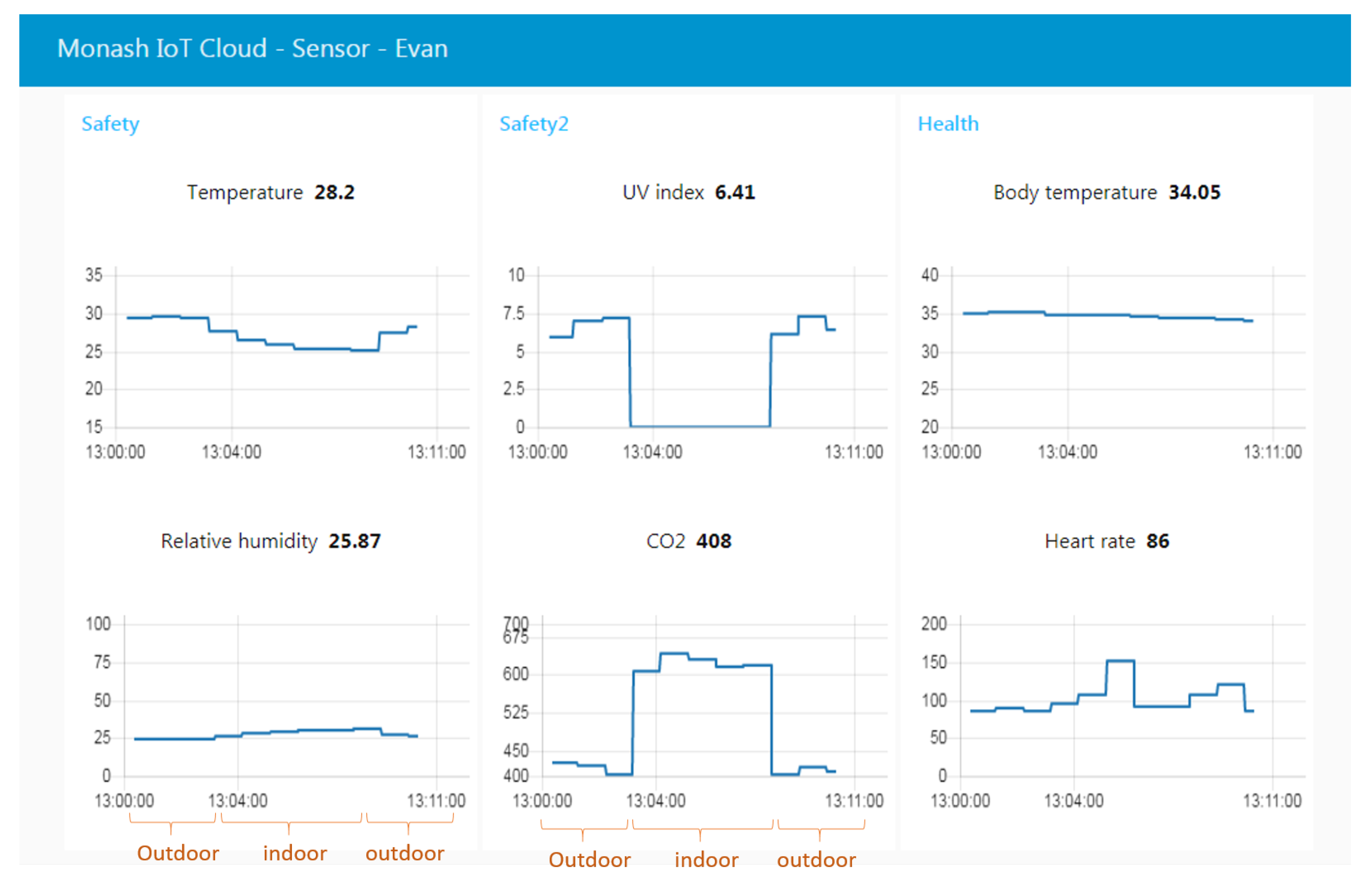
| Parameters | Model | Main Specifications | Power |
|---|---|---|---|
| MCU | Simblee | 32-bit ARM Cortex-M0 16 MHz, 29 GPIOs | Operating voltage: 1.8–3.6 V <600 nA in sleep mode |
| BLE | Simblee | −93 dBm receiver sensitivity | 8 mA TX @ 0 dBm 10 mA Rx |
| LoRa | RFM95 | −148 dBm receiver sensitivity | 20–120 mA TX 10 mA RX, 0.2 µA Sleep |
| LDO | MCP1810 | Input voltage: 3.6–5.5 V | 20 nA quiescent current 1 nA @ sleep |
| Switch | TPS22098 | Input voltage: 1–3.6 V | 1 µA quiescent current 1 µA @ sleep |
| Temperature | BME680 | −40–+85 °C | 0.15 µA @sleep 2.1 µA measuring |
| Relative humidity | BME680 | 0–100% RH | same as above |
| CO2 | COZIR-GC0012 | 0–10,000 ppm | 1.5 mA @ 3.3 V |
| UV | SI1145 | 1–11+ Index | 500 nA Sleep, 9 µA average |
| Parameters | Model | Main Specifications | Power |
|---|---|---|---|
| MCU | Simblee | 32-bit ARM Cortex-M0 16 MHz, 29 GPIOs | Operating voltage: 1.8–3.6 V <600 nA in sleep mode |
| BLE | Simblee | −93 dBm receiver sensitivity | 8 mA TX @ 0 dBm 10 mA Rx |
| Buck-boost converter | RT6150A/B | Input & output voltage: 1.8–5.5 V | <1 µA shutdown current |
| Charging controller | MCP73831 | fast charging mode constant voltage charging mode | Charging current: 15 mA–500 mA |
| Body temperature | MAX30205 | 0.1 °C (37 to 39 °C) | Operating voltage: 2.7–3.3 V Supply current: 600 µA |
| PPG | LED: AM2520ZGC09 PD: APDS9008 | Peak wavelength: 525 nm Peak sensitive wavelength: 565 nm | LED voltage: 1.6–5.5 V PD supply current: 42 µA |
| Sensor | Data | Alerts and Action |
|---|---|---|
| Temperature | >30 | remind the subject to rest and drink more water |
| UV | >5 | remind the subject to rest and avoid working under direct sunlight |
| CO2 | >800 | notify the subject to avoid working for too long in a poor air condition environment |
| Heart rate | >140 | notify subject to rest |
| Body temperature | >35 | notify subject to rest |
| Parameters | [32] | [35] | [36] | [53] | This Work |
|---|---|---|---|---|---|
| MCU | - | Cortex-M3 | CC2540 | CC2541 | Cortex-M0 |
| Wireless technologies | BLE | 6LoWPAN RFID | BLE | BLE | BLE and LoRa |
| Range | Short | Short | Short | Short | Short to Long |
| Physiological parameters | ECG, respiration, heart rate, body temperature, blood oxygen | Motion, ECG | PPG, hydration | PPG, motion, Skin impedance, ECG, VOC, ozone, respiratory rate | Body temperature, heart rate |
| Environmental parameters | temperature, humidity, noise, air quality | Temperature, barometric pressure, ambient light | pressure, gas, VOC | Ambient temperature, relative humidity | Ambient temperature, relative humidity, UV, CO2 |
| IoT realization | Yes | Yes | - | - | Yes |
| Sensor node location | Cloth | - | Wrist | Chest, wrist, handhold | Top of helmet, chest |
| Power requirements | Rechargeable battery | 3-V rechargeable battery | Solar with 20 mAh rechargeable battery | Rechargeable battery | 3.6-V rechargeable battery |
| Application | Healthcare | Healthcare system for hospital | Healthcare | Healthcare for Chronic Respiratory Disease | Safety and health monitoring for industrial workplace |
© 2018 by the authors. Licensee MDPI, Basel, Switzerland. This article is an open access article distributed under the terms and conditions of the Creative Commons Attribution (CC BY) license (http://creativecommons.org/licenses/by/4.0/).
Share and Cite
Wu, F.; Wu, T.; Yuce, M.R. An Internet-of-Things (IoT) Network System for Connected Safety and Health Monitoring Applications. Sensors 2019, 19, 21. https://doi.org/10.3390/s19010021
Wu F, Wu T, Yuce MR. An Internet-of-Things (IoT) Network System for Connected Safety and Health Monitoring Applications. Sensors. 2019; 19(1):21. https://doi.org/10.3390/s19010021
Chicago/Turabian StyleWu, Fan, Taiyang Wu, and Mehmet Rasit Yuce. 2019. "An Internet-of-Things (IoT) Network System for Connected Safety and Health Monitoring Applications" Sensors 19, no. 1: 21. https://doi.org/10.3390/s19010021
APA StyleWu, F., Wu, T., & Yuce, M. R. (2019). An Internet-of-Things (IoT) Network System for Connected Safety and Health Monitoring Applications. Sensors, 19(1), 21. https://doi.org/10.3390/s19010021






